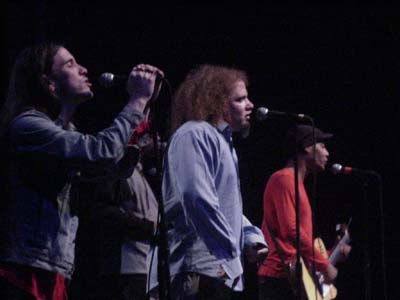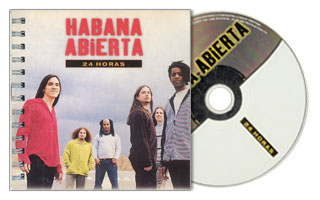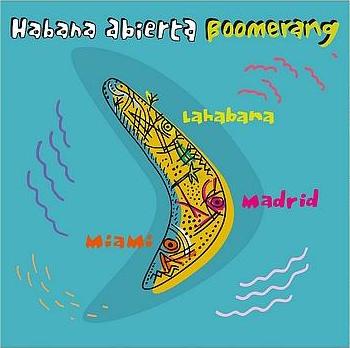Habana Abierta 24 Horas: 10 Years Later
By Dmitri Prieto

Today I want to write to pay off an old debt… we’ll see if I achieve that, if I’m able to transmit the sense of my message despite of the difference in language.
I learned of the project “Habana Abierta” (Havana Open) in 1999, after they had just recorded their most famous CD: “24 hours.”
They were Cuban musicians who traveled to Spain in the 1990s. The ’90s for Cuba is not a chronological category, but an ontological one. This period has to do with the very being of the nation. With our existence, contorted, sharply painful, whose pressure ends up being felt close the heart – like a bullet.
The ’90s caused the way of making music in Cuba mutate. Independent and alternative groups emerged, Cuban hip-hop appeared, rock music slowly rose (or quickly shook) its head, along with the “novísimos” (“newest”) literature written by authors close to rock music subcultures.
Son music turned into salsa, and salsa mutated into timba, with lyrics that heralded those of today’s reggaeton. The old “New Trova” entered into a crisis (a terminal one?) from which it has still not recovered. Havana filled with guys and gals (Yeah, and what girls those of the ’90s!) wearing long hair and dreadlocks, filled with rage against oppression and misery, and possessing tremendous creative talent and capacity for work. Legendary cultural initiatives arose out of thin air in neighborhoods like Alamar and Vedado itself.

Then several youth came together in Madrid from different musical forms (trova, rap, rock, reggae), from different races, and (very importantly!) from several parts of the Cuban Archipelago (Havana, Santiago, the Isle of Youth). With the help of other Cuban musicians living there (Gem and Pável) they recorded three CDs in a row: “Habana Oculta” (Hidden Havana); “Habana Abierta (Havana Open), and “Habana Abierta 24 Horas” (Havana Open 24 Hours).
I can’t go without mentioning their names: Vanito Brown, Luis Barbería, Alejandro Gutierrez, Jose Luis Medina, Boris Larramendi, Kelvis Ochoa, Pepe del Valle and Andy Villalón. This was an all-male ensemble, though in their concerts they included female artists, such as the multi-instrumentalist and singer Yusa.
It was the musical genre that we would later become known as “fusion”; but it was more than a fusion, it was the essence of our thoughts and feelings made into music. It was Cuban music. They were ideas. They were ideas for dancing to. Neither before nor after has there ever been anything like it: normally, you either move your ass to reggaeton beats (beats?) or give a deadpan embrace to your lady friend while listening to Silvio Rodriguez.
However, yes indeed, it’s possible to dance to the sound of:
In Buenos Aires I met a chick
That came only with the idea
Everybody who works and sweats eats, and everybody suckles who cries…
I told her “shut up and get in bed,
I already know how that movie ends”
At the end of it all, I believe she understood absolutely nothing…
The lyrics here make the following point:
“In Buenos Aires I met a girl that almost had an orgasm thinking that in a state-run society it’s possible to carry out the principle of socialist distribution (pay according to ones work) and at the same time guarantee freedom of speech and the control over the people’s leaders. I told her, “If you want sex with me, we can do that; but as for your political thesis, such a program has historically led to Stalinist-type totalitarianism.” At the end of it all, I believe she understood absolutely nothing…”
Or:
It was still beautiful but it faded
It’s not the same thing as when we were kids
Pioneers for communism!…
Mission: cosmonauts!…
A fragment providing a historical recollection of the beauty of some ideals of the day-to-day life of a child, now distant from the platonic world of ideas…
Those on the right keep turning to the right
Those on the left keep turning to the left
And now I’m already bored
of those old trips in circles…
I travel straight ahead, though I’m not an arrow
I can sign it for you, and stamp a date on it
In case you suspect, in case you suspect, in case you suspect (you big snitch!)

The thought behind the music is: Traditional political forces contribute absolutely nothing new to reflection and the current political praxis. They are essentially conservative, regardless of their party affiliation. I got bored with that position; now I’m able to maintain an ethic of rightness in my attitudes, and I publicly proclaim my choice. I don’t care if someone is suspicious of me or seeks to denounce me to the authorities, or that agents keep me under surveillance.
This song “Divino guión” (Divine script) offered an entire program of political-philosophical-cultural problematization in the codes of street language; it is still a program – 10 years later – sordidly unfulfilled by the institutes of social research and the think-tanks of the “Battle of Ideas,” despite all of the commendable efforts of so many thinking beings endowed with tears.
“Habana Abierta” became a point of the spear against the misery of totalitarianism: not only material misery, but symbolic misery as well. Their cassettes passed from hand to hand. I can’t forget that when on the political-musical map was monotonously reigned Silvio Rodriguez’s (“El necio”) and Willy Chirino “Ya viene llegando”), and – in a more apocalyptically accurate and minority vein – Santiago Feliu (“Generacion”) or Pedro Luis Ferrer (“Cubano 100%”), the polysemic problematics of Habana Abierta acquired the very status of a revelation.
It was “forbidden music” (though never officially prohibited) that later became public -what a miracle!- without losing its freshness. The National President of the Hermanos Saíz Association once told me the members of Habana Abierta were “going hungry” in Madrid. Then came the return: Habana Abierta in Havana.
The National Theater was packed, as was the Salón Rosado de la Tropical. According to Wikipedia, “around 10,000 people attended. All of the songs were sung by the public word by word, despite this being the first and only concerts of the complete group on the island up to that time.” As a friend of mine commented, “Rockers learned how to dance salsa.”
But the insertion in an official status-niche (and a new sense of day-to-day comfort given by Chavez revolution in Venezuela!) reduced the visibility of the Habana Abierta project. They were becoming a part of the general social milieu (even on Havana TV) and a legend at the same time.
Then came the Elian Gonzalez affair, reggaeton fever and the legal case of the Cuban Five. Nonetheless, the remarkable simultaneity of the tedium of reggaeton and the belligerent racket of the “Battles of Ideas” (that ended up masterfully converging in a fascistic piece by the mediocre Baby Lores, which merits its own article) has not overshadowed the problems revealed by Habana Abierta.
In addition, their innovations in terms of music have constituted the best in creativity in the past ten years by artists talented in several musical genres. For making life bearable at the end of the ’90s – between blackouts and police whistles – and for their contribution, which up until now has not be surpassed in the Cuban musical patrimony, we can only say to them one thing – Gracias!





